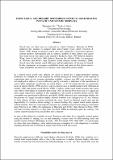Expectancy, not memory determines identical search rates in static and dynamic displays.

View/
Date
2005Author
Elliott, Mark
Metadata
Show full item recordUsage
This item's downloads: 281 (view details)
Recommended Citation
Shi, Z., & Elliott, M. A. (2005). Expectancy, not memory determines identical search rates in static and dynamic displays. In J. S. Monahan, S. M. Sheffert & J. T. Townsend. (Eds.). Fechner Day 2005. Proceedings of the Twenty First Annual Meeting of the International Society of Psychophysics. Traverse City Michigan, USA. The International Society for Psychophysics, (pp. 333-336).
Abstract
Search rates are often used as a measure of search efficiency. Horowitz & Wolfe employed this measure to compare static and dynamic visual search (Horowitz & Wolfe, 1998). Based on identical search rates, they argued that visual search operates without memory. Subsequently and in contrast a number of other authors have agued that visual search relies upon iconic memory ( Bäcker & Peral, 1999; Peterson, Kramer, Wang, Irwin, & McCarley, 2001; Scheier, Khurana, Itti, & Koch, 1999). In a reanalysis of Horowitz and Wolfe¿s data, Kornbrot found contrary results (Kornbrot, 2004). Search rates only indicate search efficiency and the implications of this may be limited. In this commentary we propose a probability model and point out that factors such as target probability and subjective expectancy may bring about similar results.

